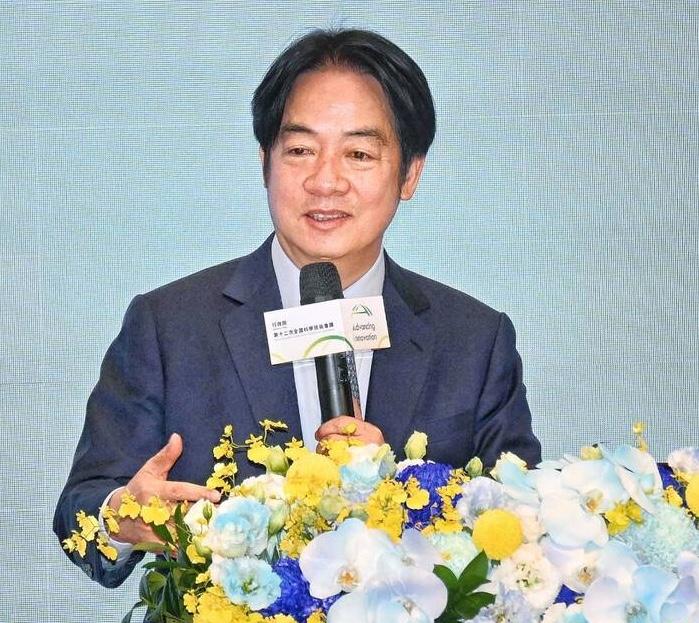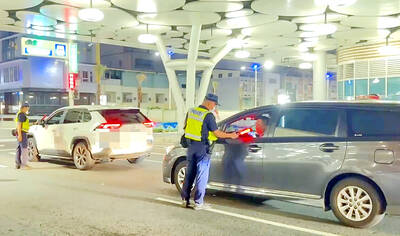The National Science and Technology Conference, held every four years, is to run from today until Wednesday, gathering leaders in industry, government, academia and research.
President William Lai (賴清德) delivered the opening speech this morning, saying that he hopes science and technology could lead the charge in facing the rise of artificial intelligence and geopolitical challenges.
The Executive Yuan’s Economic Development Commission on Thursday last week approved six flagship regional projects to build railroads, improve healthcare, expand cultural tourism and build housing in the hopes of better integrating science and technology into daily life, he said.

Photo: Fang Pin-chao, Taipei Times
Next year’s science and technology budget is set at NT$196.5 billion (US$6.5 billion), NT$7.7 billion more than last year, Lai said.
Lai said that when he was premier, the budget was only NT$100 billion, demonstrating Taiwan’s increased commitment to science and technology, he said.
Hopefully this year’s increased budget would make Taiwan a world leader in tech, he added.
The commission plans to invest in 140 major construction projects, of which 100 projects have already commenced, he said.
Drafting of national policy relies on the experience of industry and academic experts paired with technology, so discussions held at this week’s conference would be critical in future policymaking across government bodies, he said.
The conference is key to creating the nation’s blueprint for science and technology and setting mid to long-term development goals, Cabinet members and National Science and Technology Council Minister Wu Cheng-wen (吳誠文) said.
This year’s conference differs in its forward-thinking, balanced and people-focused approach to strengthening future research and development projects, Wu said.
Participants also aim to collaborate with international partners to create a global supply chain and further Taiwan’s strategic position in global technology, he added.

TRAFFIC SAFETY RULES: A positive result in a drug test would result in a two-year license suspension for the driver and vehicle, and a fine of up to NT$180,000 The Ministry of Transportation and Communications is to authorize police to conduct roadside saliva tests by the end of the year to deter people from driving while under the influence of narcotics, it said yesterday. The ministry last month unveiled a draft of amended regulations governing traffic safety rules and penalties, which included provisions empowering police to conduct mandatory saliva tests on drivers. While currently rules authorize police to use oral fluid testing kits for signs of drug use, they do not establish penalties for noncompliance or operating procedures for officers to follow, the ministry said. The proposed changes to the regulations require

The Executive Yuan yesterday announced that registration for a one-time universal NT$10,000 cash handout to help people in Taiwan survive US tariffs and inflation would start on Nov. 5, with payouts available as early as Nov. 12. Who is eligible for the handout? Registered Taiwanese nationals are eligible, including those born in Taiwan before April 30 next year with a birth certificate. Non-registered nationals with residence permits, foreign permanent residents and foreign spouses of Taiwanese citizens with residence permits also qualify for the handouts. For people who meet the eligibility requirements, but passed away between yesterday and April 30 next year, surviving family members

China Airlines Ltd (CAL) yesterday morning joined SkyTeam’s Aviation Challenge for the fourth time, operating a demonstration flight for “net zero carbon emissions” from Taiwan Taoyuan International Airport to Bangkok. The flight used sustainable aviation fuel (SAF) at a ratio of up to 40 percent, the highest proportion CAL has achieved to date, the nation’s largest carrier said. Since April, SAF has become available to Taiwanese international carriers at Taipei International Airport (Songshan airport), Kaohsiung International Airport and Taoyuan airport. In previous challenges, CAL operated “net zero carbon emission flights” to Singapore and Japan. At a ceremony at Taoyuan airport, China Airlines chief sustainability

‘ONE CHINA’: A statement that Berlin decides its own China policy did not seem to sit well with Beijing, which offered only one meeting with the German official German Minister for Foreign Affairs Johann Wadephul’s trip to China has been canceled, a spokesperson for his ministry said yesterday, amid rising tensions between the two nations, including over Taiwan. Wadephul had planned to address Chinese curbs on rare earths during his visit, but his comments about Berlin deciding on the “design” of its “one China” policy ahead of the trip appear to have rankled China. Asked about Wadephul’s comments, Chinese Ministry of Foreign Affairs spokesman Guo Jiakun (郭嘉昆) said the “one China principle” has “no room for any self-definition.” In the interview published on Thursday, Wadephul said he would urge China to